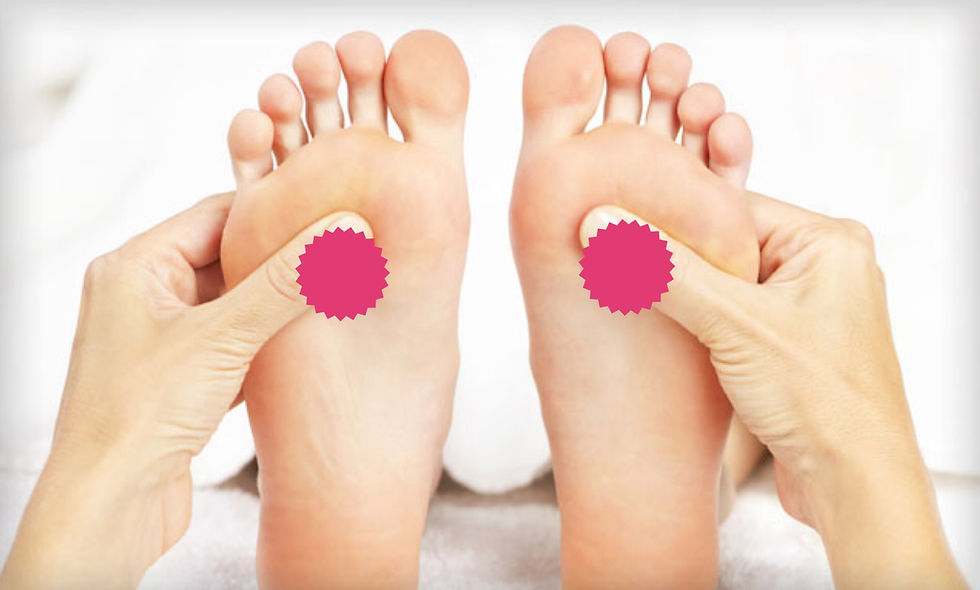Reflexology for Kids
- Jennifer Johnson

- Jun 18, 2019
- 4 min read
Updated: Sep 23, 2024
From infants to big kids, reflexology can evolve with their needs. Here are a few strategies to make reflexology kid-friendly, at every age and stage.
Boundaries for Healthy Touch
Consent is a tricky thing with tiny kids, since moods or lack of logical understanding can make it challenging for them to say yes to something they don't want at the time...especially if they are already not feeling well. The long term kids-and-reflexology relationship will grow best if it's something they have some control over, and enjoy.

As older kids understand that sometimes a little discomfort while pressing a reflex will help them feel better faster, they can cooperate with you to feel better by telling you where the tender spots are, and counting to 5 while you press them.
Lots of rewarding 'feel good' techniques woven among the tender reflex work helps kids focus on the positive, and build a strong base in self-healing they can use on their own later.
With every age kid, no means no. Respect consent and boundaries, and work when you can, stopping when they indicate they are done, even if it means your "session" was only 3 minutes long.
Reflexology Evolution
1. At infancy, catch your baby in a good mood, and make the reflex points part of your personal contact routine, with lots of smiles and positive interaction. That way, when it's needed at a time of discomfort and unhappiness, like during teething, your baby will welcome it the same way he would welcome a snuggle.
Alternatively, you can press on some reflexes while baby sleeps. Keep reflex massage gentle and short.

Some suggested reflexes for babies:
upper arch of the foot for upset stomach and to calm
toes for teething and sinuses
big toe pad and thumb pad for pain
lower arch f the foot for constipation or diarrhea
ear lobes for fever
2. Toddlers and young kids will let you do reflexology over and over, when you turn it into a little game. Use the Three Little Piggies as a base to build your own story, that works reflexes for the immune system when kids have a cold or flu.
"Piggies" Game: As you go through the commonly known little piggies rhyme, rub, roll or squeeze the pad of each toe, to work head and sinus reflexes.
Pay special attention to gliding along the edge of the big toe, beside the second toe, to affect the throat reflex.
Invent a version where each piggy then runs down a 'path', by running your finger down each channel between the bones, on the top surface of the foot. These areas represent lymph drainage, armpit and chest lymph - important parts of the immune system. You can also affect lymph by squeezing the webbing between the toes.
Finally, press or glide your finger along the crease of the ankle joint as you have the little piggies run around the 'tree' (leg), as the ankle area represents groin lymph.

3. Older kids may start coming to you for reflexology by request, or you might offer it when illness develops.
For any illness, teach kids to tap the thymus body reflex, at the sternum, mid-chest, to stimulate this very important gland.
Because it is most important in childhood as it contributes to building a strong immune system, the thymus remains large and active until puberty, when it then naturally starts to shrink. The thymus reflex on the sole of the foot is located mid-ball of the foot, in a direct line down from the webbing between the first and second toes.
Growing pains may be helped by pressing along the arm and leg reflexes, along the outer border of the bottom of the foot (the outer edge of the 'footprint').
4. Teens who may not want to talk to you about 'awkward' body changes at puberty, may still let you rub their feet. Especially work the big toe for important hormone glands, and the outside of both heels for either the ovary or testicle reflexes. For females who have started their periods, they can do a circular rub around their wrists to help ease cramping.

Squeezing the fleshy part of the hand, down from the webbing between the thumb and index finger, helps relieve headaches and other pain, and can relieve nausea.
Show all older teens how to help their brains at exam time by pressing the tips of all toes and fingers, and how to calm anxiety by pressing into the solar plexus reflex (pictured) on the hands or feet.


You don't have to be a professional reflexologist to share the benefits of reflexology. Caring, respectful human touch teaches kids about permission, boundaries and helpful contact, while also imparting a trust in the body's ability to help itself.
Come to Summer school! Learn more reflexology strategies for kids at our class, Kids & Reflexology: Success Strategies and Formulas.
Jennifer Johnson is a reflexology therapist with 20 years’ experience running a successful practice; she is Director and Instructor at the federally recognized Atlantic School of Reflexology, offering professional certification courses in Canada.
Disclosure Statement: This article may be freely printed or distributed in its entirety via social media, e-zine, newsletter, blog or website, with author's name and website links intact and included.
Want to know more? See here for related courses or email info@reflexologyasr.com

Comments